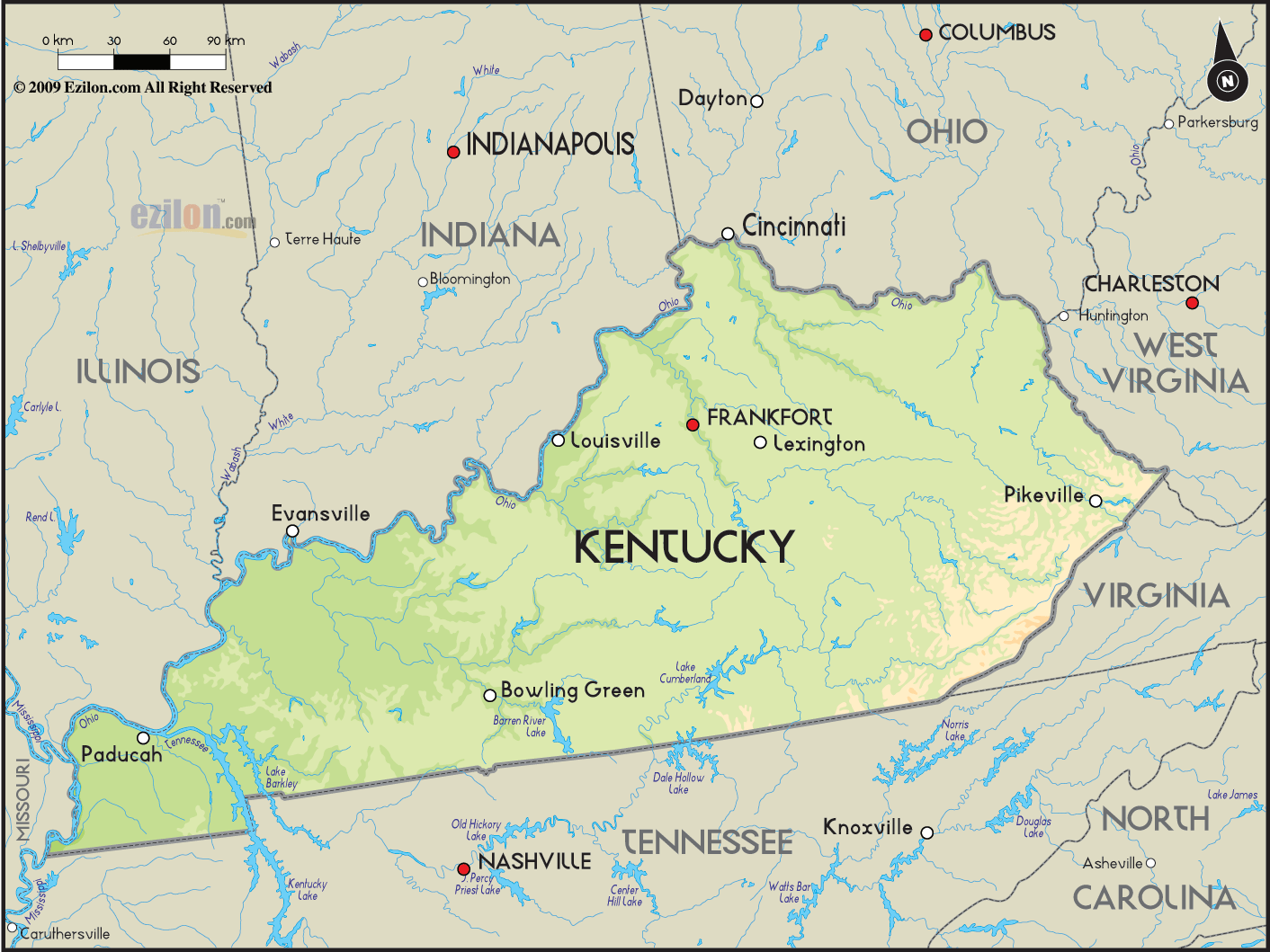Kentucky's Civil War Puzzle: Was KY Confederate Or Union?
Have you ever wondered about Kentucky's true allegiance during the American Civil War? It's a question that, quite frankly, gets a lot of folks scratching their heads. You see, this particular state holds a very unique spot in the story of that great conflict, not quite fitting neatly into either side.
For many, the Civil War brings to mind clear lines: North versus South, blue versus gray. But Kentucky, a southern border state of key importance, complicated that simple picture. It was, in a way, a state caught right in the middle, trying its best to avoid picking a team, at least at first. This position made its story, you know, really fascinating and, well, a bit messy.
So, was Kentucky truly Confederate or Union? The simple answer is, it's not so simple. We'll take a look at the twists and turns, the declarations, the battles, and the people who made Kentucky's role in the Civil War one of the most talked about aspects of the era, even today, in fact.
Table of Contents
- The Early Stance: A Proclamation of Neutrality
- Kentucky: A Crucial Border State
- Neutrality's End: The Invasion and Its Fallout
- Two Governments, One State: A Divided Allegiance
- The Battleground State: Conflicts Within Kentucky
- Kentuckians on Both Sides: A Personal Choice
- The Aftermath: Echoes of Division
- Frequently Asked Questions About Kentucky's Civil War Role
- A State Divided: The Enduring Legacy
The Early Stance: A Proclamation of Neutrality
At the very start of the Civil War, Kentucky, you know, decided it wasn't going to pick a side. It officially announced its neutrality, a position that, in some respects, seemed like a good idea to avoid the coming storm. This was largely due to the state’s strong traditions as a border area, with connections and sympathies stretching both north and south. The people there, quite honestly, had family and business ties on both sides of the growing divide.
In May 1861, Kentucky’s governor, Beriah Magoffin, made this neutral stance very public. This proclamation, in a way, made things even more complicated for both the Union and the Confederacy. Each side, you see, really wanted Kentucky on their team, but the state was trying to stay out of the direct fighting. It was a rather delicate balance, to be honest.
This early position meant that, at the beginning of the war, both Union and Confederate forces generally kept their armies out of the state. They were, instead, taking tactically advantageous positions in neighboring states, just watching and waiting. It was, you know, a sort of uneasy peace, a quiet before the storm that everyone knew was coming, sooner or later.
Kentucky: A Crucial Border State
Kentucky was, without a doubt, a border state, standing between the Confederate states and the Union of the North. This geographic spot gave it immense importance to both sides, so much so that President Abraham Lincoln, famously, once declared, "I hope to have God on my side, but I must have Kentucky." That quote, you know, really tells you a lot about how vital the state was considered to be for the Union's success.
Its position meant it was a gateway, a place where armies could move and supplies could flow. For the Union, keeping Kentucky out of Confederate hands was absolutely essential for protecting the Ohio River and the states north of it. Losing Kentucky would have pushed the Confederate line much further north, making the war, arguably, much harder to win for the Union.
The state's resources, its population, and its rivers were all factors that made it a prize for both warring factions. It was, you know, a bit like a strategic chess piece on a very large board. Both sides, naturally, tried to influence Kentucky's allegiance, even when it was officially neutral, because its role was so incredibly significant.
Neutrality's End: The Invasion and Its Fallout
Despite Kentucky’s official neutral stance, that position couldn't hold forever. Both Union and Confederate forces, as a matter of fact, broke through Kentucky’s neutrality in the summer of 1861. It was, you know, a sign that the war was simply too big to respect such a delicate agreement. The first major breach came from the Confederate side.
On September 2, 1861, Confederate troops, led by General Leonidas Polk, moved into Columbus, Kentucky. This move was an effort to take the state for the Confederacy, but it backfired rather spectacularly. This act, you see, ended Kentucky's official neutrality once and for all. It was, quite frankly, the turning point.
After this failed attempt by Polk to grab the state, Kentucky’s legislature, now seeing the threat clearly, asked the Union army for help. The Union responded by bringing its forces into the state, effectively aligning Kentucky with the Union side for the rest of the conflict. This shift, you know, was a huge win for President Lincoln and the Union cause, really.
Two Governments, One State: A Divided Allegiance
Even after Kentucky officially leaned Union, things remained, you know, pretty complicated. In 1861, while Union and Confederate armies had forces in different parts of the state, a Confederate government of Kentucky was born. This was, basically, a shadow government, formed by Confederate sympathizers who wanted Kentucky to join the South. It was, in a way, an attempt to create an alternative reality for the state.
This Confederate government, however, had a short, very fragile existence. It never really held widespread power or control over the state's official workings. Nevertheless, on this date, the shadow government's hopes came true when the Confederacy, in fact, took Kentucky in as its 13th Confederate state. This was, of course, based on the actions of this alternative government, not the official one.
For a time, the Confederacy actually had power over more than half of Kentucky, but only until 1862. The Union's continued presence and military efforts eventually pushed back Confederate control. This dual government situation, you know, really shows how deeply divided the state was, with loyalties pulling in different directions, sometimes within the same family, too it's almost.
The Battleground State: Conflicts Within Kentucky
Because of its crucial position and divided loyalties, Kentucky became a significant battleground during the American Civil War. There were, as a matter of fact, 13 battles that happened in this state between Union and Confederate forces. These clashes, you know, really brought the harsh realities of the war home to the people living there.
Though the South would try to retake Kentucky later in 1862, the failure of this effort meant that the state stayed firmly in control of the Union for the rest of the Civil War. This was, arguably, a huge blow to Confederate hopes, as they had counted on Kentucky's strategic value. The battles fought within its borders, such as Perryville, were pivotal in securing Union control.
The constant presence of both armies, and the fighting that resulted, meant that Kentucky, a state that had initially tried to stay out of the conflict, ended up playing a very direct and active role in it. It was, you know, a place where the lines between Union and Confederate were not just political, but often, literally drawn on the ground where people lived and fought.
Kentuckians on Both Sides: A Personal Choice
Perhaps one of the most striking aspects of Kentucky's Civil War experience is that soldiers from Kentucky actually served in both the Union and Confederate armies. This fact, you know, really underscores the deeply personal and often agonizing choices people had to make during that time. It wasn't always a clear-cut decision for many families.
Even though Union recruiting camps had been set up in the commonwealth, many Kentuckians, for their own reasons, chose to fight for the Confederacy. This meant that, quite literally, brothers might find themselves on opposing sides of a battlefield. It was, basically, a war that divided communities and even households, which is a pretty stark image.
The state formed military units for both the Union and Confederate causes. This list of units, you know, truly reflects Kentucky's unique status as a neutral southern border state with two competing governments. It's a powerful reminder that allegiance during the Civil War was, for many, a very individual and complex matter, not just a state-wide declaration.
The Aftermath: Echoes of Division
The divisions within Kentucky didn't simply vanish when the fighting stopped. The echoes of the Civil War, you know, continued to be heard for many years afterward. This lingering influence is perhaps best seen in the political choices made by the state's citizens and its legislature long after the war concluded.
For example, in 1875, the Kentucky legislature chose Francis M. Cockrell, a former Confederate general, to represent the state in the United States Senate. Four years later, he was joined by George G. Vest, who had, in fact, represented the state in both pre-war and post-war capacities. This shows, quite clearly, that Confederate sympathies still held significant sway in the state's political landscape.
These choices, you know, illustrate that while Kentucky remained under Union control throughout the war, the hearts and minds of its people were, in many cases, still very much split. It was, basically, a state trying to put itself back together, but with strong memories and loyalties to both sides of the conflict still very much present, even decades later.
Frequently Asked Questions About Kentucky's Civil War Role
Why did Kentucky declare neutrality during the Civil War?
Kentucky declared its neutrality at the beginning of the war, largely because of its strong border traditions. It was, you know, an effort to stay out of the direct conflict and maintain peace within its own borders. Governor Beriah Magoffin made this position public in May 1861, hoping to avoid picking a side.
How did Kentucky's neutrality end?
Kentucky's neutrality officially ended on September 2, 1861. This happened when Confederate troops, led by General Leonidas Polk, moved into and occupied Columbus, Kentucky. After this, the state legislature asked the Union army for help, bringing Kentucky into the Union fold for the rest of the war, as a matter of fact.
Did Kentucky officially join the Confederacy?
While a shadow Confederate government of Kentucky was formed in 1861 and accepted by the Confederacy as its 13th state, the official state government did not join the Confederacy. After its neutrality ended, Kentucky remained firmly under Union control for the duration of the conflict, despite Confederate efforts to take it, you know.
A State Divided: The Enduring Legacy
So, was Kentucky Confederate or Union? The answer, as we've seen, is a fascinating story of a state caught in the middle. It tried neutrality, played a crucial role as a border state, saw its neutrality breached, and even had two competing governments. Its people, too, fought on both sides of the terrible conflict, which is pretty telling.
Kentucky's journey through the American Civil War shows us that history is rarely black and white. It's full of nuances, difficult choices, and unexpected turns. To really understand this pivotal period, it's helpful to explore the experiences of places like Kentucky. You can learn more about Kentucky's Civil War history on our site, and perhaps, you know, discover even more about this complex era by checking out historical resources like those at the National Park Service Civil War site. There's so much to uncover, and stuff.
If you're interested in the details of the battles fought in this state, you can also find out more about them here. It's a truly remarkable part of our past, one that continues to shape our understanding of the nation's struggles and triumphs, even today, in fact.

Moving to Kentucky | Living in Kentucky

Geographical Map of Kentucky and Kentucky Geographical Maps

Kentucky